This Ducati 750 GT road test is to give you an understanding of this incredible Italian classic motorcycle and what it really is like to own and ride. The first of the Ducati round case L shaped big twins in the round case series proved to be an outstanding road going motorcycle. The first of these rare machines was delivered in 1971 with a production of 690 units that year. The greatest year for production was just 1,17 in 1973. The series ran, except for 40 units produced in 1978, from 1971 to 1974. The total of machines produced was 5,284 which makes them very rare indeed. These are rarer than the Vincent 1000 V twins of which they produced around 6,900 or maybe more. Arriving two years after Honda’s mighty CB750 with its across the frame bulky, four-cylinder motor, the Ducati is a svelte and agile machine. Although the Ducati produces 57 BHP and the Honda 67 BHP, the Ducati feels much more powerful than it seems on paper, it handles and stops much better than the Honda. Although it’s not much bigger than a Ducati 450 Desmo and it’s a great long journey machine.
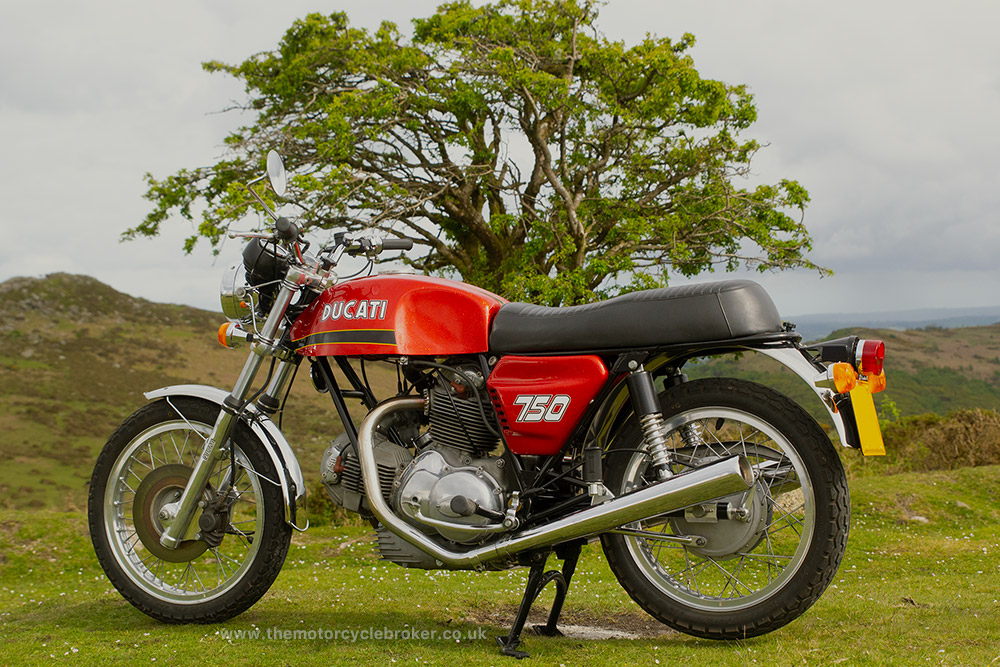
Classic Italian Motorcycle
This classic Italian motorcycle is an unsung hero of the classic motorcycle world. It’s everything a classic motorcycle is about and is an under the radar Italian classic motorcycle which will gain in status and value in the coming years. The motor itself is a work of art and is about to be featured in our project The Motorcycle as Art. The rest of the machine is of the highest quality with differing components for different series and even for some markets. Importantly, the brakes are of the finest quality whether they are Brembos, Scarab or Lockheed. The chassis is outstanding and the bike will scratch the chassis on corners without even trying, while nothing seems to upset the bike’s cornering line. Owners spend tens of thousands of pounds trying to make Vincent 1000 V twins stop, go and corner like the 750 GT and fail miserably, never getting close. The Ducati holds its own against the most powerful motorcycles of the day. It still feels lively, very well mannered and really quite superior, even by modern motorcycling standards, and it oozes soul. That soul has been missing from modern digital motorcycles for decades and these machines breath it with every RPM. They are a James Brown to Vincent’s Cliff Richard when it comes to soul. This is the epitome of class, grace and soul in the form of a classic Italian motorcycle.
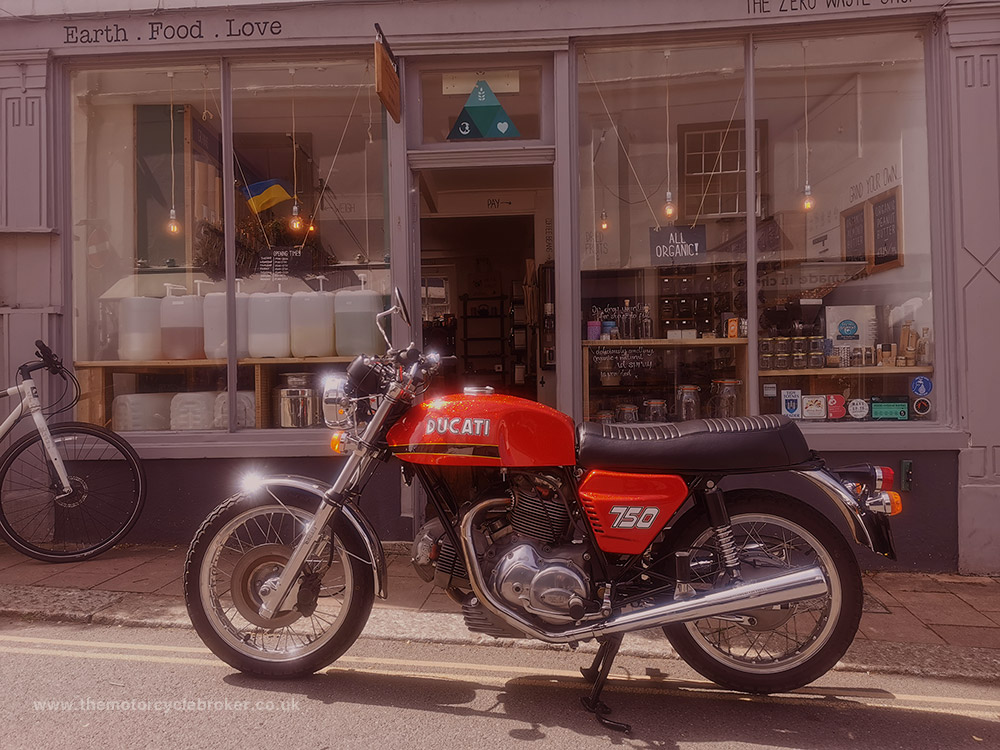
Round case Ducati motor
The round case Ducati motor was made in very small numbers and was the company’s first attempt at a large capacity motor. It was an incredible success and created a range of motorcycles that are iconic and magical. This motor was used in the 750 GT, the 750 Sport and the 1974 750 SS, or green frame, you can read this article about the series by Ian Falloon. The motor itself looks like a work of art from both sides and the eye is drawn straight to it in all of the Ducati range of motorcycles that it was powered by. There will never be a time in history again when such motorcycles will be produced. Because the motors took so long to build when new, Ducati lost a fortune on every motorcycle. At the end of each year the Italian government wrote the factory’s debt off and the whole cycle started again at the beginning of the new financial year, until it was bought by Cagiva in about 1985. Every Ducati that was built in this era was subsidised by the Italian government and sold at a loss. That is why this series of motorcycles was so beautiful and the beauty they created cost the Italian government. Quite simply, when building a vehicle, curves cost and the round case was round and very curvy. The entire motorcycle range was round, very curvy and incredibly beautiful. The square case series came about because Ducati had pretty much been ordered to stop building large motorcycles by the Italian government. The designers created the square case engine, which only took half a day to build new in the factory. The government relented, but still had to subsidise every machine which went into a showroom but not to such an extent as the round case series.
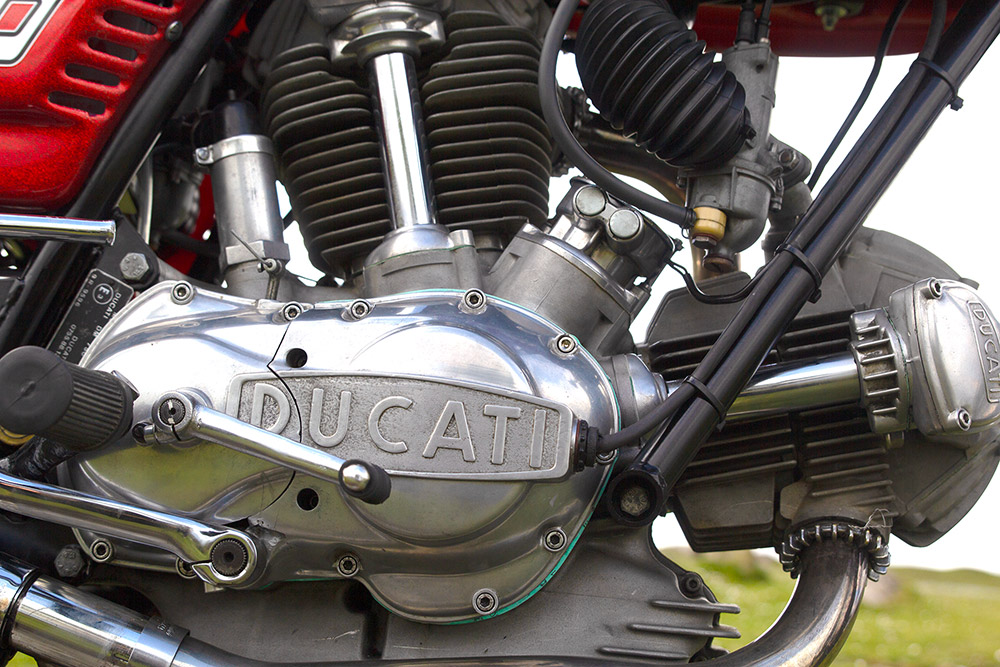
Beautiful to ride
The 750 GT round case is beautiful to ride, yet it all starts before first gear is even selected. Set up correctly, these always start first kick and the roar from the Conti pipes changes the world in an instant. Even sat stride the motorcycle, your left foot on the ground will feel a passionate heart beat through its soul with every explosion in each combustion chamber. Passers-by are drawn to the pandemonium of that first roar on start-up and then the promising heartbeat of a syncopated tick over. The gearbox is silky smooth, but requires firmness like all machines from this era. Sat astride the machine, as you open the throttle, the open bell mouths’ sound of gulping air is as loud as the throaty Conti pipes, and they are thunderous. Pulling away, the motor is smooth and promises so much which it delivers to excess, as it shakes window panes. The 32 mm Dellorto carbs pull crisply and cleanly all the way up to the 8,000 RPM red line. Yes! 8,000 RPM from a 750 cc L shaped twin from 1971. The bevel drives allow this crazy red line, for a large capacity L shaped twin, because the valve timing remains constant even at such high revs. Cam chains won’t allow a large L shaped twin to rev out like a four-cylinder Japanese motorcycle, as the CB750 revs to 8,500 RPM. However, the Ducati delivers its power cleanly from tick over right through the rev range and just pulls more and more as the motor spins freely without concern.
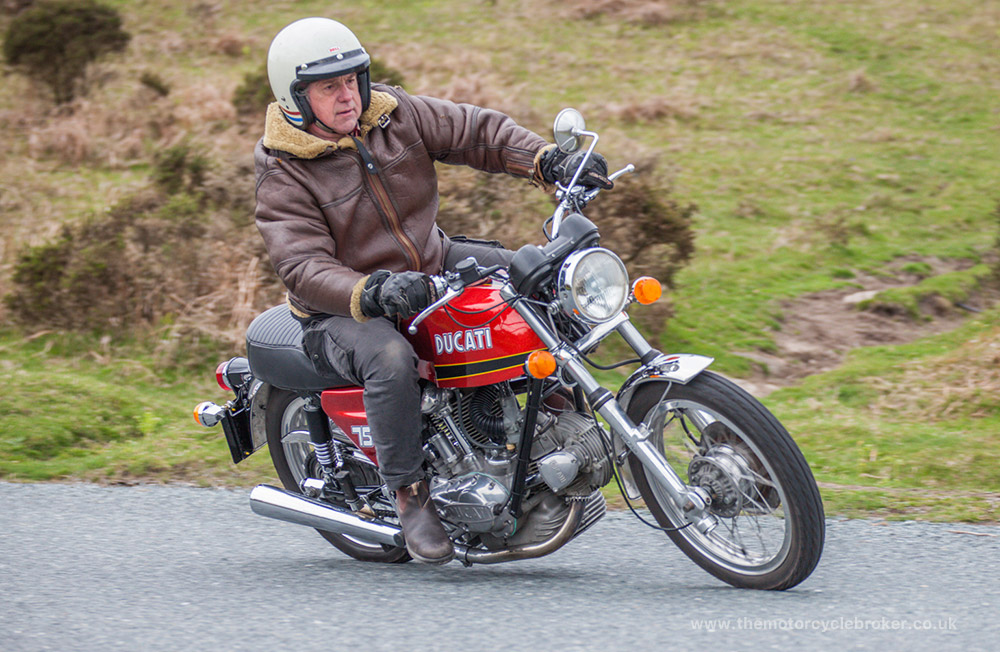
Motorcycling art
The round case is pure motorcycling art in every respect, the choice of colours in the colour schemes, the shape of the round case motor and the entire motorcycle are a work of art. The early 750 GTs were sand cast motors and they are becoming very expensive and collectible. The early bikes, even after the sand casts, had some wild paint schemes, like this one featured in this road test in sparkle red fibreglass bodywork which were produced until 1973. Although the sparkle paint scheme was really very rare, others came in black or plain red and there was a sparkle blue paint scheme too. The fibreglass body works were all coloured gel coat and not paint. Later series had steel body work and colour matched front and rear mudguards, instead of the polished stainless-steel items fitted to the early machines. These later series had interesting colour schemes with a candy bronze and black with hand painted white pinstripes all over the bodywork. The entire motorcycle is a work of art in every way as well as being fast, capable, cornering really well and stopping brilliantly. What more could you want from an Italian classic motorcycle, well this Ducati 750 GT road test will reveal even more about this historic classic motorcycle.
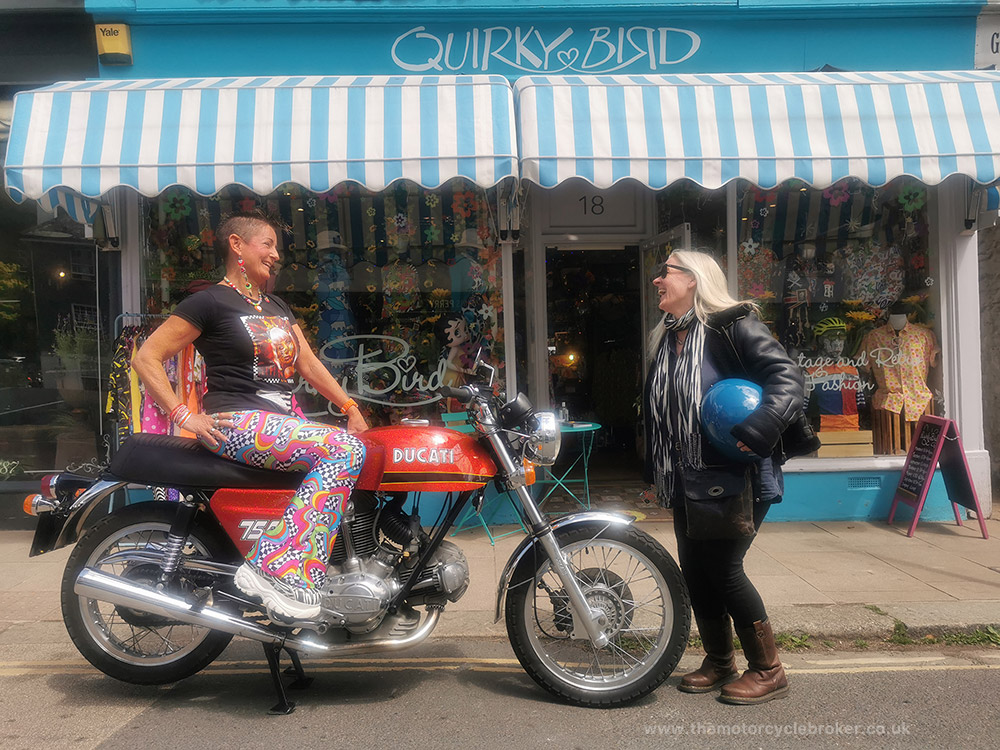
A Ducati for long journeys two up
This is a Ducati for long journeys two up, even though it looks like it should be cramped and the seat seems small. The seat is in fact a great size and I’m suffering with middle age spread. My partner has travelled for several hours two up and she reports that she was very comfy all the way throughout the journey. The photos show how low the steady 750 GT can go with ease and it will go much further. These photos were taken just after the roads were re-surfaced on Dartmoor last summer and they were covered in loose chippings. In spite of the loose chippings, the frame would still touch down on cold tyres with ease! There is something so very special about this motorcycle, because it is comfortable. Much as I love the Ducati 750 Sport (you can read that road test here) I find dropped bars very uncomfortable at my age, after between ten minutes and two hours depending on the motorcycle. The 750 GT has handlebars at the perfect height for us “not so keen any more on ace bars and clip-ons”. The seat is comfortable, the entire bike is comfortable, it handles like a dream, stops brilliantly, it goes like stink and is a work of art. There is no other classic motorcycle in the world which offers so much and is at the same time so practical and so soulful. On top of all of this, it sounds fantastic too.
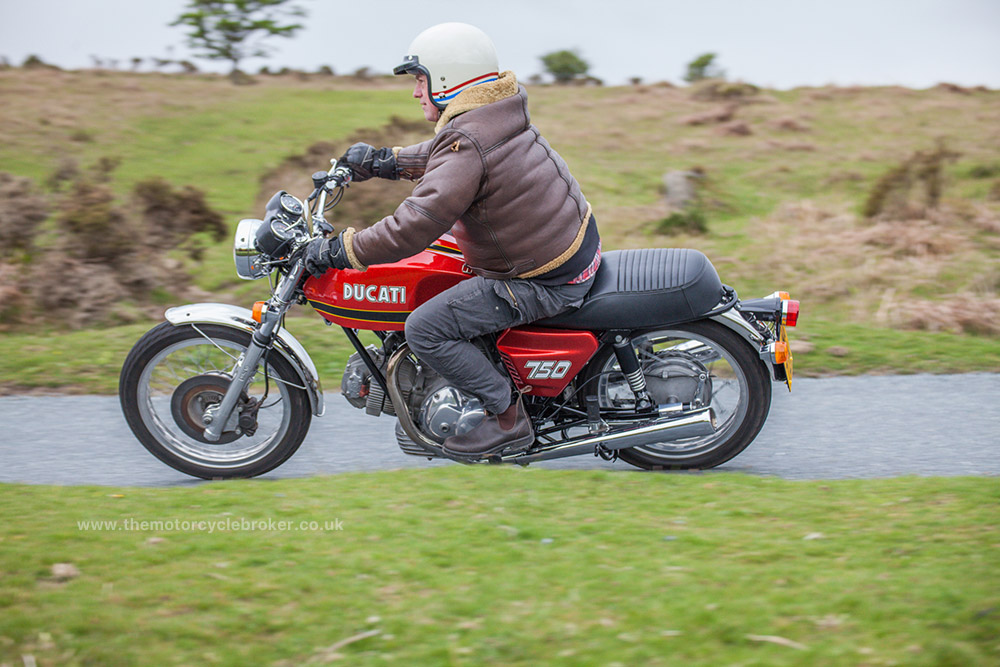
Investment grade Ducati 750 GT
An investment grade Ducati 750 GT is the most cost-effective way of acquiring one of these beauties. Buying one to do up is extremely costly and you may never get it to an investment grade condition. These motors took a day and a half to build new at the factory, because the cranks are a handful and the bevels have to be shimmed at the top and the bottom. It’s a labour of love but once they’re set up, they’re good for over a hundred thousand miles, as they’re an all-aluminium engine. It is foolish to buy a machine which does not have all the original parts, as you just won’t find them. If you’re lucky enough to get hold of the parts you need, you’ll be paying crazy prices to secure the part and then you’ll have to restore the part as well. There are plenty of them that look pretty, but flatter to deceive, they’re not investment grade and never will be. These will increase in value enormously and they are a joy to own and ride. This round case series of machines came from an era of engineering subsidised by the Italian government which will never be seen again. This series of motorcycle from the 750 GT to the green frame, is unsurpassed in design, quality and artistry. They are destined to be iconic classic motorcycles which will reach unimaginable heights in future values. Unfortunately, it is impossible to write just a Ducati 750 GT road test because there is so much more to this Italian classic motorcycle than riding it. If you want to buy an investment grade Ducati 750 GT, contact The Motorcycle Broker.
- Most collectible Ducati 916 SP - June 20, 2024
- Classic Motorcycles: To ride or not to ride? - June 17, 2024
- Classic Motorcycles: To ride or not to ride? - June 17, 2024








Leave a Reply